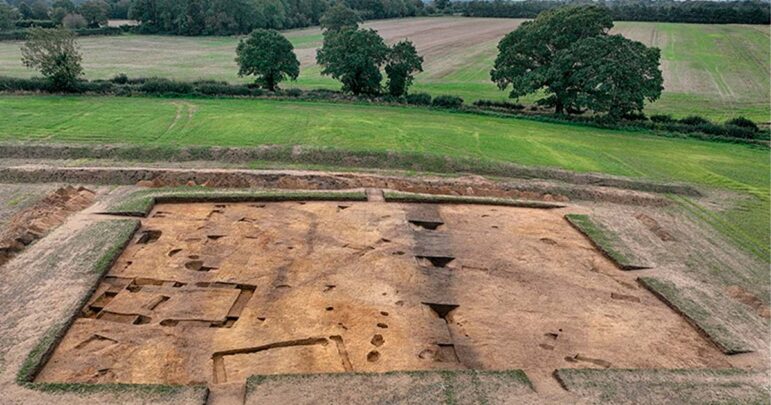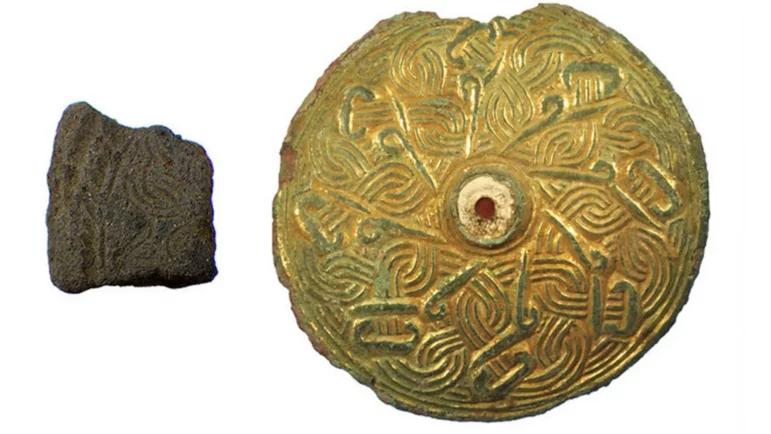
IPSWICH, England- A 4-year archaeological project, named Rendlesham Revealed and funded by the National Lottery has revealed a possible Anglo-Saxon temple site near Sutton Hoo in Suffolk. Sutton Hoo is, of course, well known for its famous ship burial and appearance in the recent film ‘The Dig,’ but this new discovery could shed additional light on the history of the area. Basil Brown, played by Ralph Fiennes in the film, also excavated Rendlesham but on this occasion did not make significant discoveries. British Archaeology magazine describes the area as “Rendlesham is everyday life, while Sutton Hoo is extraordinary death.”
The site has been suspected of being a major centre of Saxon life for decades and in 2008 the landowner, Sir Michael Bunbury, asked the conservation team at Suffolk County Council to investigate further, in order to discourage metal detectorists tramping over his land. When they began to make preliminary enquiries, they found Saxon artefacts across a widespread area – but also evidence of modern theft.
The site itself dates from the 7th century and, experts say, shows the power and wealth of the East Anglian kings. The complex, near Rendlesham near Woodbridge, covers 50 hectares and consists of three timber buildings, one of which is suspected to be a temple, but there is evidence of occupation on the site from the Neolithic period onwards and some of the site seems to have been occupied by small family farms, with royal life at the centre of the settlement. There is also mention of the site by early historian the Venerable Bede in his Ecclesiastical History Of The English People (731CE), who describes it as a royal site.

An aerial image of the excavation site showing the possible temple or cult house (left) and ditch (centre). [Image credit: Suffolk County Council; photo by Jim Pullen]
Evidence of metalworking has been found, such as a mould for making horse harnesses of the kind that were found at Sutton Hoo itself, but also jewellery and clasps for dressmaking. Traces of these – such as scraps of gold and casting sprues – were mainly found in one location, suggesting the existence of a workshop. Coins and weights were also discovered, suggesting that the site saw a number of high-level currency transactions. The kind of jewellery that was made – and worn – here is comparable to the finds at Sutton Hoo nearby.
Professor Christopher Scull, of Cardiff University and University College London, who is the project leader, told the press, “The results of excavations at Rendlesham speak vividly of the power and wealth of the East Anglian kings and the sophistication of the society they ruled. The possible temple, or cult house, provides rare and remarkable evidence for the practice at a royal site of the pre-Christian beliefs that underpinned early English society. Its distinctive and substantial foundations indicate that one of the buildings, 10 metres long and five metres wide, was unusually high and robustly built for its size, so perhaps it was constructed for a special purpose. It is most similar to buildings elsewhere in England that are seen as temples or cult houses, therefore it may have been used for pre-Christian worship by the early kings of the East Angles.”
Who were these early kings? Bede tells us that Swithelm, the king of the East Saxons, was baptised at Rendlesham. Occupation of the site is estimated to have taken place between the 5th and 11th centuries, with the community being at the height of its wealth and power between the 6th and 8th centuries (as noted, the buildings discovered date from the 7th century), after which it began to decline, probably as a result of the increasing power of the port at Ipswich.
If one of the buildings is a temple, it will be only the second Saxon temple discovered in Britain, although there are several Saxon temple complexes on the Continent. In the UK, the only other known site is Yeavering, in Northumbria. Professor Scull told the BBC that
“We assume they had a pantheon of gods, and we believe an individual chose to align themselves with a particular god or demi-god. One of the things Bede says is that Raedwald [d. CE 624] backslides after his conversion to Christianity and kept altars to Christ and to other pre-Christian gods – in their world view Christ may be just another powerful god among many.”

Evidence of high-quality craftsmanship including a fragment of a mould (left) used for metalworking a horse harness mount [Image credit: Suffolk County Council]
We do not know a great deal about Raedwald – although he was a powerful king, he died fighting the Vikings and they subsequently destroyed many details of his reign that had been kept in local monasteries. Some experts believe him to have been buried at Sutton Hoo, but as Gavin Bone pointed out in our previous article covering the film The Dig, there have also been indications that the ship burial belonged to a Danish king. The whole area really needs to be considered in a European context, not just a British one, as the incoming Saxons retained strong links with kingdoms in northern Europe.
Bede tells us that Raedwald was married to a pagan woman and that she persuaded him to lapse from full commitment to Christianity (his household apparently wasn’t overwhelmed about converting, either), which led to Bede’s disapproval of this Saxon monarch. Do we know which god Raedwald would have worshipped? We do not have hard evidence, but Rædwald was a descendent of the Wuffinga family, who claimed direct descent from Woden, thus some historians think that this deity is the most likely candidate for Rædwald’s worship.
According to Bede, King Ealdwulf (664 – 713 CE) saw the temple with the two altars to Christ and to the Saxon gods when he was a boy. According to some accounts, this was apparently a temple constructed at the wish of Raedwald’s wife, so this would have been a pagan temple with a Christian altar installed in it – and now this temple might have been discovered.
More information about the site will be released in the archaeological report, which should come out in 2024. We will be reporting on it in due course, since if the building on the site is indeed King Raedwald’s temple, it is of major significance to British Pagans, Heathens in particular.
The Wild Hunt is not responsible for links to external content.
To join a conversation on this post:
Visit our The Wild Hunt subreddit! Point your favorite browser to https://www.reddit.com/r/The_Wild_Hunt_News/, then click “JOIN”. Make sure to click the bell, too, to be notified of new articles posted to our subreddit.
